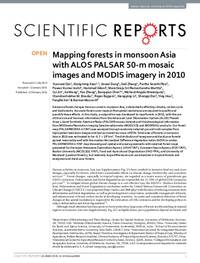Mapping forests in monsoon Asia with ALOS PALSAR 50-m mosaic images and MODIS imagery in 2010

Authors:
Extensive forest changes have occurred in monsoon Asia, substantially affecting climate, carbon cycle
and biodiversity. Accurate forest cover maps at fine spatial resolutions are required to qualify and
quantify these effects. In this study, an algorithm was developed to map forests in 2010, with the use
of structure and biomass information from the Advanced Land Observation System (ALOS) Phased
Array L-band Synthetic Aperture Radar (PALSAR) mosaic dataset and the phenological information
from MODerate Resolution Imaging Spectroradiometer (MOD13Q1 and MOD09A1) products. Our forest
map (PALSARMOD50 m F/NF) was assessed through randomly selected ground truth samples from
high spatial resolution images and had an overall accuracy of 95%. Total area of forests in monsoon
Asia in 2010 was estimated to be ~6.3 × 106 km2. The distribution of evergreen and deciduous forests
agreed reasonably well with the median Normalized Difference Vegetation Index (NDVI) in winter.
PALSARMOD50 m F/NF map showed good spatial and areal agreements with selected forest maps
generated by the Japan Aerospace Exploration Agency (JAXA F/NF), European Space Agency (ESA F/NF),
Boston University (MCD12Q1 F/NF), Food and Agricultural Organization (FAO FRA), and University of
Maryland (Landsat forests), but relatively large differences and uncertainties in tropical forests and
evergreen and deciduous forests.
